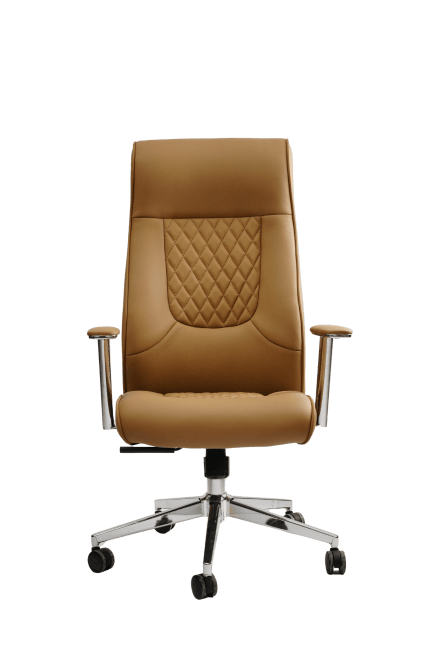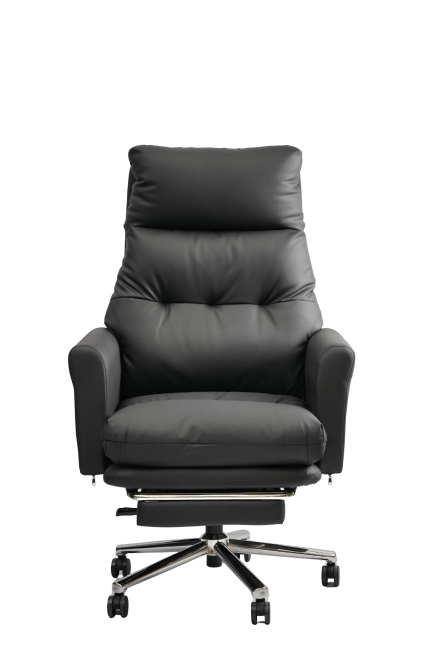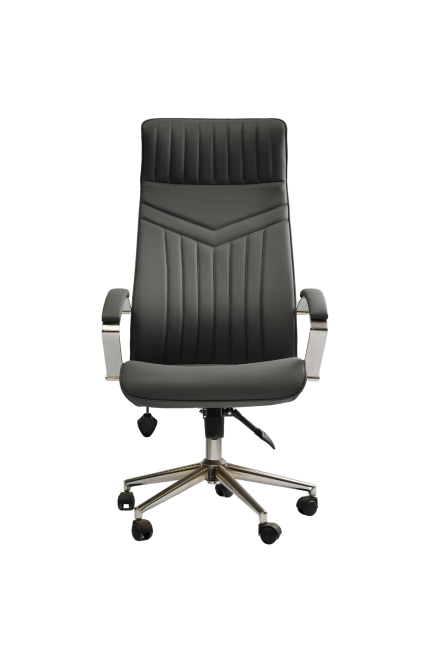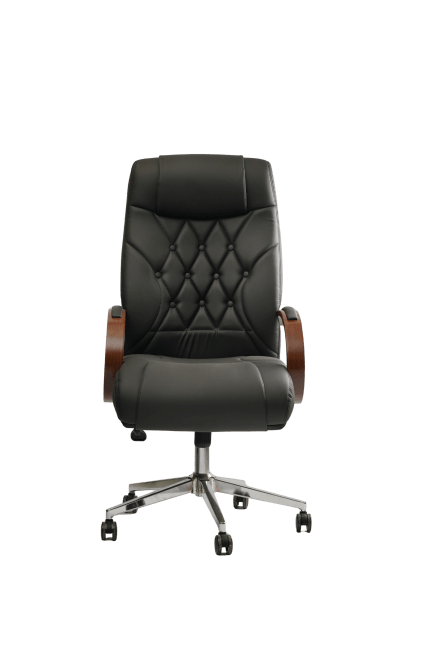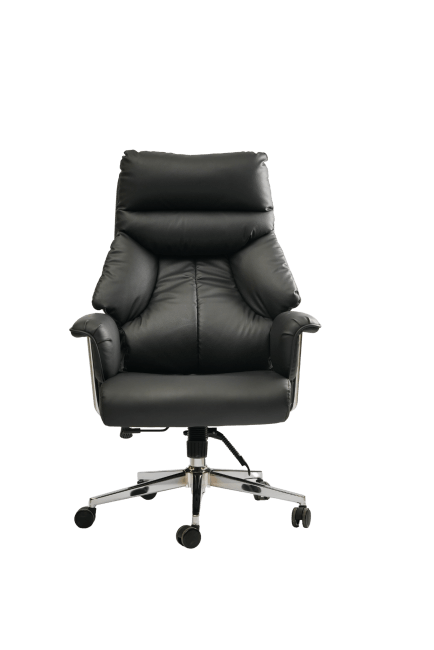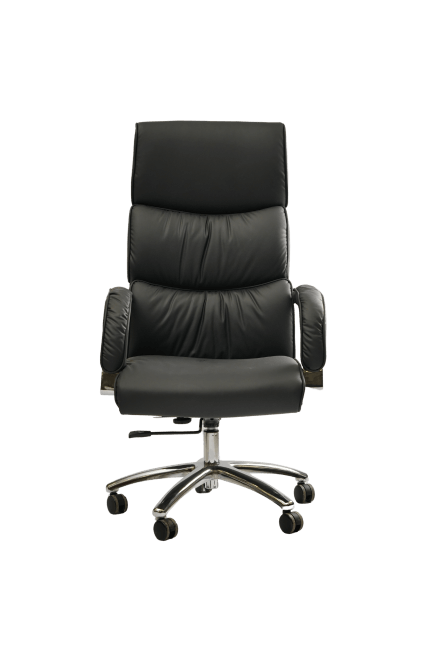Executive chair
Executive chair
An executive chair is a type of furniture that holds a special place in the office environment, both in terms of functionality and aesthetics. These chairs are designed to allow executives to sit comfortably for long working hours. Their design is usually enriched with a luxurious appearance, high-quality materials, and innovative mechanisms. One of the main elements that ensure comfort is their ergonomic structure. Ergonomic design protects spinal health and prevents back, neck, and shoulder pain. When choosing an executive chair, the material, mechanism, and additional features are of great importance. These chairs are not only about comfort but also serve as visual elements that reflect the executive’s status and prestige. Being made of high-quality leather or textile ensures long-term satisfaction for the user. The sturdiness of the base increases the durability of the chair. Properly placed armrests prevent arm fatigue during work. Mechanisms play an important role in adjusting the height and tilt angle of the chair. The lumbar support, designed to match the spine’s structure, provides maximum support for the user. Special features, such as a massage function or heating system, further increase the value of the chair. In terms of color, executive chairs are often produced in neutral and elegant tones. Compliance with quality standards in production ensures the chair’s longevity. Some models can recline, allowing the chair to be converted into a resting mode. Control systems should be simple and easy to use. In electric models, the power source enables all additional functions to work smoothly. Ultimately, an executive chair is an essential office element from aesthetic, functional, and health perspectives.Material
The material of an executive chair directly affects both its comfort and durability. High-quality leather or eco-leather models provide a luxurious appearance and are easy to clean. Textile covers, on the other hand, are breathable, offering comfort during long-term use. Leather chairs are usually preferred in prestigious offices, while textile chairs dominate in modern office designs. The density and elasticity of the foam used inside the chair also determine seating comfort. High-density foam retains its shape for a long time without deforming. A metal frame structure ensures the chair is stronger and longer-lasting. Plastic components reduce weight, but they must be of high quality to avoid breaking over time. Water- and stain-resistant materials make it easier to keep the chair clean. The stitching technique used is also an indicator of material quality. Good stitching not only creates an aesthetic look but also ensures long-term use. The material choice directly affects the price of the chair. Higher-quality materials are more economical in the long run. When choosing an executive chair, it is important to ensure that the material is both visually and functionally compatible with the office design.
Armrests
The armrests of an executive chair are an important part that provides user comfort. They are usually designed to be adjustable so that they can fit different heights and body types. Soft-padded armrests reduce pressure on the elbows and wrists during long sitting hours. In some models, armrests can be adjusted for height, angle, and forward-backward movement. These features are essential for ergonomic comfort. The material of the armrests also reflects the overall quality of the chair. Leather- or textile-covered armrests provide both aesthetic and functional advantages. Armrests with metal or strong plastic bases are more reliable in terms of durability. Proper placement of armrests reduces tension in the shoulders and neck. The shape of the armrests should match the user’s individual needs. Some executive chairs have foldable or removable armrests. This allows multifunctional use of the chair. Stable armrests also contribute to the overall sturdiness of the chair. From a design point of view, armrests are also elements that complement the aesthetic appearance of the chair. Comfortable and functional armrests positively affect work performance.
Base
The base of an executive chair is one of the key parts that ensure its stability and mobility. The base is usually made of strong metal or high-quality plastic. Metal bases are more reliable in terms of durability and can withstand heavy weights. Plastic bases, on the other hand, make the chair lighter and easier to move. The five-star base system is often used to maintain balance. Swivel casters at each end allow smooth movement around the office. The caster material should be chosen according to the surface – rubber for carpeted floors and hard plastic for hard flooring. The height of the base also affects the overall ergonomics of the chair. The golden standard is for the legs to maintain a 90-degree angle at the knees. Some models come with a locking caster system to prevent unwanted movement. The paint and coating on the base complete the chair’s aesthetic appearance. For long-term use, it is important that the base does not rust or peel. Proper weight distribution of the chair also depends on the design of the base.
Mechanism
The mechanism of an executive chair is one of the most important elements that determine its comfort level. Some of the most commonly used mechanisms are the swing and multiblock systems. The swing mechanism allows the backrest to move forward and backward. The multiblock system is distinguished by its ability to lock at different angles. These mechanisms allow the user to adjust the seat angle and tilt to personal comfort. The gas lift system makes it easy to adjust the height of the chair. The quality of the mechanism guarantees long-term trouble-free use. Additionally, some models integrate vibration and massage functions into the mechanism. A high-quality mechanism works quietly and does not produce disturbing noises while sitting. The balance system distributes the user’s weight evenly, increasing comfort. Protection against rust is also important for the mechanism components. Multifunctional mechanisms allow the chair to be used both for work and rest. The sturdiness of the mechanism directly affects the overall value of the chair.
Lumbar Support
The specially shaped aluminum lumbar support of an executive chair provides both strength and aesthetics. Although aluminum is lightweight, it is highly durable. This material resists rust and maintains its shape and appearance for many years. Movable lumbar support can move forward and backward to match the user’s sitting posture. This feature ensures continuous support for the lower back. The adjustable system allows the user to change the height of the lumbar support according to their height. This helps maintain the natural curve of the spine and prevents back pain. The ergonomic shape distributes pressure evenly across the lower back, allowing comfortable long-term sitting. Mesh lumbar supports improve ventilation and prevent sweating. Leather-covered models provide a classic and prestigious look. Some premium models also include massage and heating functions in the lumbar area. The strong frame of the lumbar support retains its shape during long-term use. Its special design complements the overall look of the chair both functionally and visually. The movable and adjustable nature of lumbar support also positively impacts user productivity. The combination of these features makes the executive chair an ideal choice in terms of both health and comfort.
Color
The color of an executive chair should be chosen to match the office environment’s design. Classic black, brown, and beige are the most preferred tones. These colors create a serious and prestigious image. In modern offices, gray, white, and even blue tones are also popular. The color may look different depending on the material. On leather covers, the color appears more glossy and elegant, while on textile covers it looks soft and matte. For color durability, the material must be resistant to fading. In chairs exposed to sunlight, protective coatings are used to preserve the color. When choosing a color, harmony with office furniture and wall tones should be ensured. The color also reflects the executive’s personal taste. Some manufacturers can apply any desired color as a custom order. Choosing the right color is an important factor that completes the overall appearance of the chair.
Production
The production of an executive chair is a process that requires precise engineering and high-quality standards. The first stage of production is determining the chair’s design, where ergonomic features are prioritized. Once the design is approved, the frame of the chair is produced. The frame is usually made of steel or strong aluminum, giving it durability. After the frame is completed, the material selection stage begins. Leather, eco-leather, or textile covers are prepared using special cutting technology. The seat and backrest are filled with high-density foam to ensure comfort. Mechanism parts are manufactured separately and then assembled into the chair. During installation, each part must be tested to ensure proper function. The base and casters are produced separately and then attached to the main body. The painting and coating process completes the chair’s aesthetic appearance. Every chair undergoes a quality check before leaving production. These tests cover durability, functionality, and comfort. The tools and technologies used during production directly affect the final quality of the chair. In handmade production, more attention is paid to detail. In mass production, automated lines speed up the process, but quality control remains essential. Some manufacturers produce custom-designed executive chairs upon request. A high-level production process results in a product that is perfect both visually and functionally.
Reclining Function
The reclining function of an executive chair allows it to be used for relaxation in addition to work. This function is based on the backrest reclining backward and the seat moving forward. The recline angle varies depending on the model; some chairs can recline up to 170 degrees. This feature is ideal for short breaks after long working hours. The reclining function is controlled by a mechanism, usually activated with a lever or button. In high-quality mechanisms, the movement is quiet and smooth. Reclining chairs often come with a leg rest that extends for a comfortable lying position. This improves blood circulation and reduces fatigue. In some models, the reclining function can be locked so the chair remains stable at any angle. It also helps reduce stress in the office. This feature makes the chair multifunctional. A high-quality reclining system increases the longevity of the chair. The strength of the mechanism prevents the chair from wearing out quickly. Executive chairs with a reclining function, especially premium models, are often chosen for executive offices. Such chairs provide an ideal solution for both work and short relaxation. In terms of user comfort, the reclining function is an irreplaceable advantage.
Control
The control system of an executive chair is one of the main factors that determine its comfort level. Control is usually performed via mechanical levers, buttons, or electronic panels. Traditional mechanical controls are simple and reliable. Electronic control, however, provides more functionality. Through these systems, it is possible to adjust the chair’s height, tilt angle, and sometimes even the massage function. Since the control elements are placed within easy reach, functions can be accessed quickly. Ergonomically placed control panels make it convenient to adjust while sitting. In some models, a remote control connects wirelessly to the chair, adding extra comfort. Clear and simple symbols on the control system make it intuitive to use. Electronic control systems may also include a memory function, allowing the user to quickly restore pre-set positions. The quality of the control system determines the overall functionality of the chair. Multifunctional control systems allow the chair to be used for both work and relaxation. Mechanical control may be more durable, but electronic control provides greater convenience. The durability of the control section ensures long-term trouble-free operation.
Power Source
The power source of an executive chair is mainly used to operate its additional features. Functions such as massage, heating, and USB charging require power. The power source is usually supplied via the electrical grid or batteries. Models connected to the electrical grid provide a continuous energy flow. Battery-powered models offer wireless convenience but need to be recharged periodically. The choice of power source depends on the chair’s intended use. For stationary office use, grid power is more suitable. For mobile chairs that are often relocated, battery versions provide convenience. The power source must comply with safety standards. Overvoltage protection increases the chair’s lifespan. The cable length should be chosen according to the location of the chair. Some models feature an energy-saving function that automatically shuts off when not in use. The power source can also be integrated into the chair’s design, helping preserve its aesthetic appearance. Using high-quality components in the power supply ensures the smooth operation of all functions. A reliable power source effectively supports all the additional features of the chair.
Special Features
The ergonomic design of an executive chair is made to support the natural shape of the body during long working hours. The ergonomic structure helps reduce tension in the spine, neck, and shoulder areas. An adjustable headrest allows neck support to be personalized for comfort. This minimizes fatigue and pain in the neck area. Height-adjustable lumbar support ensures that the chair’s back support is optimally positioned according to the user’s height. This helps preserve the spine’s natural S-curve. Seat adjustment according to body size ensures that the legs and knees are placed at the correct angle. The seat depth and height can be adjusted to personal needs. The massage function stimulates blood circulation and relaxes muscles while sitting. This feature is especially beneficial for those who work long hours in front of a computer. The massage function may include different modes and intensity levels. In some models, the heating function works together with the massage, providing additional comfort. All adjustable elements are equipped with easy-to-use control mechanisms. Thus, the user can quickly and easily switch to any desired position during work. The combination of these functions elevates the executive chair to a high level in terms of both health and comfort.
Get a quote with one click!
Fill out the form and get a private individual offer for your business as soon as possible.




